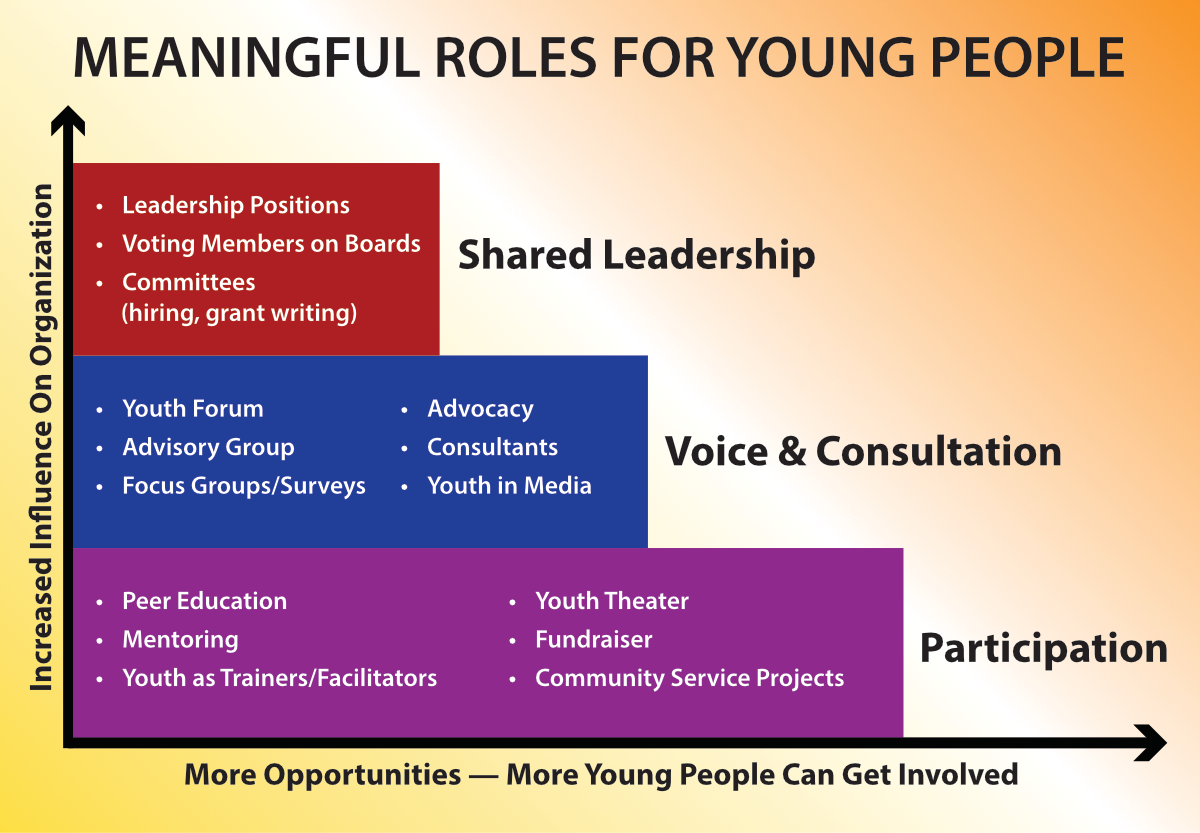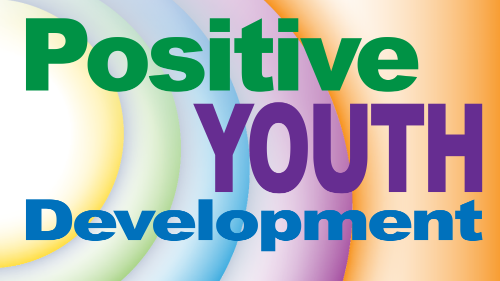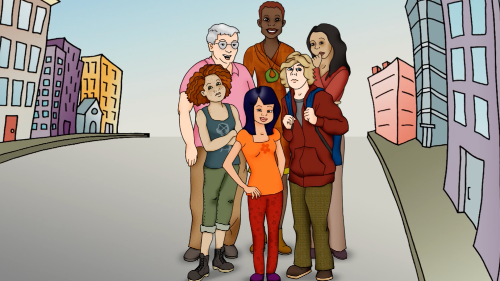What is Youth Engagement, Really?
Youth engagement is central to positive youth development. When we engage authentically with youth, we work with young people, not for them, toward shared goals. We prepare ourselves and our organizations for inclusive youth engagement and shared decision-making. We listen to young people's expertise and perspectives, prepare them for meaningful roles of their choosing, and create effective youth-adult partnerships. We foster mutual accountability.
Here's our definition. Youth engagement happens when young people participate in meaningful opportunities and roles that allow them to build on their strengths, take on responsibilities, and contribute to decisions that affect themselves and others.
- In program, organizational, and community contexts, youth engagement involves collaboration between adults and young people toward shared goals.
- The engines of youth engagement are strength-based relationships, experiences, and environments that offer opportunities for positive development.
- True youth engagement requires that adults share power with youth. Adults are accustomed to making the decisions in program and organizational contexts and are typically not accustomed to ceding power to young people. Preparing adults for youth engagement — including power sharing — is essential.
- Youth engagement typically involves young people taking on new roles. Preparing youth for new roles and responsibilities is essential.
What are meaningful roles and opportunities?
When we say "meaningful roles and opportunities," we mean that young people choose to engage in activities at any of the following levels:
- Activities that support shared goals: Youth choose to participate in challenging activities in service of a shared goal. Some activities may be short term or require light commitment (e.g., attending a workshop on managing finances) while others may be more involved and require greater responsibility and preparation (e.g., cofacilitating a sex education training). Also called "project engagement," this level of engagement offers the greatest number of opportunities and provides a good entry level for young people to develop skills, interests, and commitment.
- Voice and consultation: Youth are asked for their ideas and opinions to inform practice and policy decisions. Youth are prepared for consultation (understand the purpose, goal, and context) and are generally compensated for their work. Ideally, adults report back to youth on the outcomes of the consultation. Examples include participation in focus groups, advisory boards, hiring committees, etc.
- Shared leadership: Youth and adults engage in partnership and shared decision-making to achieve shared goals. Authentic youth voice and partnership is reflected in organizational policy and practice. Youth and adults are prepared for partnership, and organizational infrastructure (e.g., budget, policy) is put into place to support the partnership. Youth are compensated for their work. Organizations can offer fewer opportunities at this level of engagement, but the experiences are deeper and potentially more valuable. The young people involved need to make a bigger commitment of time and regular attendance. This level also requires certain skill sets and a more comprehensive understanding of the organization's mission and goals.
These different levels offer a range of meaningful roles requiring varying levels of commitment from both the young people and the organization. Not every young person wants to sit on the board of directors or take on the responsibilities of a youth advisory council; some will find a better fit for their interests at the project or consultation level. All levels provide opportunities for input and leadership. This framework allows young people to identify and build on their strengths and interests and advance to other opportunities over time.
Why is Youth Engagement Important?
Important for Youth
Human development happens through interaction with other people and social systems. To mature, we need experiences and relationships that challenge us. Ideally, development occurs within supportive environments, giving us opportunities to belong, develop competencies, build on our strengths, find our passions, and contribute to others.
In our society, these opportunities are not as abundant as we need them to be. Many young people grow up with few positive relationships and inadequate opportunities to explore who they are and what they bring to the world. Too often the opportunities a community offers do not invite all young people in, are designed to meet adult needs rather than young people's needs, or fail to account for trauma.
When we successfully engage youth in programs and organizations, young people learn that they matter. They experience belonging and connection. And they develop and exercise competencies that will help them achieve their goals.
Important for Adults
For those of us who work with young people, youth engagement is how we succeed. We cannot "develop" a young person without their participation. We won't know if our programs are working — or why they are not working — unless we ask our participants. We need young people at the table if we are going to design effective solutions to any issues that arise. Learning from our colleagues and remembering our own adolescent experiences are both valuable, but youth culture is constantly changing, and our past experiences do not precisely match what our participants are going through. As has often been said, young people are the experts in their own lives. We need the perspectives and partnership of the young people we work with to achieve our shared goals (and even our own program goals, which youth may not share). And young people can change us, too, in positive ways.
For those who do not work directly with youth, the benefits are similar though the context is different. Many of the challenges in our communities involve adolescents and young adults, and we will not solve community problems without relying on the insights and strengths of youth.
Barriers to Authentic Youth Engagement
Naturally, adults in the organization have to be open to including young people in organizational processes. Youth engagement loses authenticity when adults are conflicted about questions of power and control. In his Ladder of Children's Participation (see Resources below), Roger Hart described in detail levels of non-authentic and authentic youth engagement. The first levels of manipulation, decoration, and tokenism denote failed or false attempts at youth engagement, when young people appear to be in decision-making positions but in reality have no or very little input on events.
Adultism
A powerful underlying reason for non-authentic youth engagement is adultism — the behavior and attitudes that flow out of negative stereotypes adults hold about young people (see Resources). Adultism is rooted in the belief that young people lack intelligence or ability. This belief is strongly supported by societal norms which leave young people feeling that they are not valued, respected, or heard.
Unhealthy Environments
Adultism is not the only unconscious bias adult leaders may bring to encounters with youth. We all absorb toxic cultural prejudices (racism, sexism, ableism, etc.). When adults do not examine, check, and unlearn our biases we can create environments where young participants repeatedly experience unintentional but damaging assaults on their identities.
Even adults who deeply care for young people may have internalized these misconceptions and may not be aware that they are behaving in an adultist or otherwise biased manner. This is why adult preparation is so important to successful youth engagement.
Resources
Youth Participation Models
Organizing Engagement, an online publication working at the intersection of education organizing, engagement, and equity, provides useful summaries of youth engagement models. Organizing Engagement.
Understanding Adultism
This 1995 article by John Bell, defines "adultism" and discusses its implications for our work with young people. The Freechild Project.
Framework for Understanding Adultism
This handout describes several pitfalls created by adultism. ACT for Youth.
Inclusiveness: Building Stronger Connections
Here we share resources to help professionals assess their own biases, address bias and inclusion in programming and classrooms, and create inclusive environments. ACT for Youth.
Creating Inclusive Program Environments for Youth with Different Abilities
This training curriculum aims to provide youth work professionals with information, practices, and activities that will help them promote inclusion and engagement for all young people. ACT for Youth.





